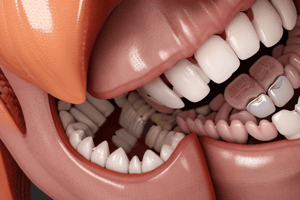Podcast
Questions and Answers
What is the primary function of incisors?
What is the primary function of incisors?
- Cutting and shearing food (correct)
- Tearing food
- Crushing food
- Grinding and chewing food
How many total molars are typically present in a complete set of permanent teeth?
How many total molars are typically present in a complete set of permanent teeth?
- 12 (correct)
- 10
- 8
- 14
What structure is primarily responsible for anchoring a tooth to the jawbone?
What structure is primarily responsible for anchoring a tooth to the jawbone?
- Enamel
- Crown
- Root (correct)
- Dentin
At what age is a complete set of primary teeth generally achieved?
At what age is a complete set of primary teeth generally achieved?
What type of dentition occurs between the ages of 6 to 12?
What type of dentition occurs between the ages of 6 to 12?
Which dental arch accommodates the upper teeth?
Which dental arch accommodates the upper teeth?
What is the term used to describe the alignment and contact between upper and lower teeth?
What is the term used to describe the alignment and contact between upper and lower teeth?
Which of the following factors can influence dental variation?
Which of the following factors can influence dental variation?
Flashcards are hidden until you start studying
Study Notes
Human Dentition Morphology
-
Definition: The study of the structure, form, and arrangement of teeth in humans.
-
Types of Teeth:
- Incisors:
- Function: Cutting and shearing food.
- Location: Front of the mouth (central and lateral).
- Number: 8 total (4 upper, 4 lower).
- Canines:
- Function: Tearing food.
- Location: Next to incisors.
- Number: 4 total (2 upper, 2 lower).
- Premolars:
- Function: Crushing and grinding food.
- Location: Between canines and molars.
- Number: 8 total (4 upper, 4 lower).
- Molars:
- Function: Grinding and chewing food.
- Location: Back of the mouth.
- Number: 12 total (6 upper, 6 lower), including 4 third molars (wisdom teeth).
- Incisors:
-
Dental Formula:
- Permanent teeth: 2-1-2-3 (upper) / 2-1-2-3 (lower) = 32 teeth.
- Primary (deciduous) teeth: 2-1-2 (upper) / 2-1-2 (lower) = 20 teeth.
-
Tooth Structure:
- Crown: Visible part above the gumline.
- Root: Anchors tooth to the jawbone.
- Enamel: Hard, outer covering of the crown.
- Dentin: Layer beneath enamel, makes up most of the tooth.
- Pulp: Soft tissue containing nerves and blood vessels.
-
Dentition Phases:
- Primary Dentition:
- Begins around 6 months.
- Full set by age 3.
- Mixed Dentition:
- Transition phase between primary and permanent teeth.
- Generally occurs between ages 6 to 12.
- Permanent Dentition:
- Begins after loss of primary teeth.
- Full set typically achieved by age 21.
- Primary Dentition:
-
Dental Arch Forms:
- Maxillary Arch: U-shaped, accommodates upper teeth.
- Mandibular Arch: Horseshoe-shaped, accommodates lower teeth.
-
Occlusion:
- Refers to the alignment and contact between upper and lower teeth.
- Types:
- Normal occlusion: Ideal alignment.
- Malocclusion: Misalignment affecting bite and jaw function.
-
Variation Factors:
- Genetic factors.
- Environmental influences (diet, habits).
- Age and developmental stages.
Human Dentition Morphology
- Human dentition morphology refers to the structural characteristics and arrangement of teeth in humans.
- Four main types of teeth serve specific functions:
- Incisors: Primarily for cutting and shearing food; located at the front; total of 8 teeth (4 upper, 4 lower).
- Canines: Designed for tearing food; positioned next to incisors; total of 4 teeth (2 upper, 2 lower).
- Premolars: Used for crushing and grinding food; located between canines and molars; total of 8 teeth (4 upper, 4 lower).
- Molars: Specialize in grinding and chewing food; found at the back; total of 12 teeth (6 upper, 6 lower), including 4 third molars (wisdom teeth).
Dental Formula
- Permanent teeth dental formula: 2-1-2-3 (upper) / 2-1-2-3 (lower) = 32 teeth.
- Primary (deciduous) dental formula: 2-1-2 (upper) / 2-1-2 (lower) = 20 teeth.
Tooth Structure
- Crown: The visible part of the tooth above the gumline.
- Root: Stabilizes and anchors the tooth to the jawbone.
- Enamel: The hard outer layer of the tooth's crown, providing protection.
- Dentin: Beneath the enamel, it comprises most of the tooth's structure.
- Pulp: The soft tissue within the tooth containing nerves and blood vessels.
Dentition Phases
- Primary Dentition:
- Begins around 6 months of age, with a complete set by age 3.
- Mixed Dentition:
- Transitional phase between primary and permanent teeth, occurring between ages 6 to 12.
- Permanent Dentition:
- Starts after the loss of primary teeth, with a full set typically achieved by age 21.
Dental Arch Forms
- Maxillary Arch: U-shaped form accommodating the upper teeth.
- Mandibular Arch: Horseshoe-shaped form accommodating the lower teeth.
Occlusion
- Refers to how upper and lower teeth align and contact each other.
- Normal Occlusion: Represents ideal alignment of teeth.
- Malocclusion: Misalignment that can affect biting and jaw function.
Variation Factors
- Genetic influences can affect tooth morphology and arrangement.
- Environmental factors, such as diet and habits, play a role in dental variations.
- Age and developmental stages also contribute to changes in dentition.
Studying That Suits You
Use AI to generate personalized quizzes and flashcards to suit your learning preferences.




